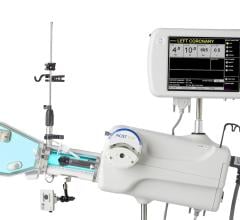In 2006, 141 million imaging examinations, including MRI, CT, PET and SPECT, were performed worldwide using a contrast media injector. In many cases, clinicians used power injectors not only for diagnostic studies, but also for interventional procedures.
Cardiologists have commonly used power contrast media injectors to achieve opacification for these diagnostic procedures, which require high flow, high volume, fixed rate injections delivered with relatively high pressures. Typical applications of this sort are ventriculograms, aortograms and run-off studies.
However, until recently, the use of power injector devices for interventional applications has been atypical in the cath lab. Instead, manual syringes and manifold sets are used for interventional procedures, which require low, variable flow rate injections.
The trouble with power injectors
There are several reasons given for why coronary diagnostic studies and interventions generally do not use power injectors. One is a perceived lack of need – current manual processes are well established and existing tools perform adequately. There may be greater risk related to high pressures introduced into relatively small and delicate vasculature. In addition, there may be safety issues with the air handling in available devices. A manual syringe, on the other hand, provides detectable pressure feedback, which is lost in a power injector. Plus, several questions remain concerning power injectors. How intuitive is a power injector and how easily can it be integrated into the routine of a cath lab? What is the impact of power injections on catheter behavior within vasculature. In other words, sudden high flows could cause catheter whipping.
Innovations overcome obstacles
Recently, new power injectors that address these technical deficiencies have entered the market. Medrad introduced a next-generation fluid management injection system, the Avanta Fluid Management Injection System. This system is intended to inject contrast in variable mode at low flow rates and low pressures for coronary and small vessels, and fixed mode at high flow rates and high pressure injections for larger vessels and peripherals. It also reportedly provides the ability of automatic saline flush. Designed with safety and ease of use in mind, features include single-patient and multipatient disposables; a redundant air management system with fluid level sensing and gross air detection; a bolus sharpness feature; variable and fixed-flow delivery; a hand controller for reduced stress induced on the palm of the hand when hand injecting; and automatic transition from injection to hemodynamic state.
Medrad also introduced extravasation detector technology for the Stellant CT Injection System, which is designed to sense extravasation pooling under the skin during a CT procedure. The Medrad XDS Extravasation Detector uses radio frequency (RF) wave technology and a physical property called permittivity. Once it detects the start of an extravasation under the patient’s skin, it signals the Stellant to stop injecting until a clinician can examine the patient.
Employing RF wave technology and permittivity enables the detector technology to minimize false positive detections, which can interrupt workflow and inhibit productivity. They are also a major reason why previous extravasation devices that use the indirect detection method of impedance and resistivity have not been readily adopted.
In addition, Medrad is offering the Pres Pressure-Rated Extension Set for CT power injection. The FDA recommends using only venous access devices that are compatible with the high pressures achieved when power injecting. Pres is designed to reduce the risk of disposable extension set rupture during powered injection of contrast agent or saline when using Medrad’s CT injection systems.
Improving upon user-controlled, variable-rate delivery of contrast media for both large and small vessel angiography, Acist offers contrast delivery systems, the CMS, Voyager and the ACIST Cvi.
Innovations in these systems include variable-rate contrast delivery systems for precision and control. By adjusting the pressure applied to the AngioTouch hand controller, the user can make variable-rate adjustments of contrast flow and volume.
Tracking injection data
The ability to capture, store and retrieve data produced by the injector such as flow-rate and volume injected is useful for budgeting and tracking of contrast utilization. A unique feature that the E-Z-EM injector systems offers is the Injector Reporting information System (IRiSct), which the company says is the first database management system for injection/contrast data. The information can be sent using standard protocols to any PC within the facility’s network.
Another new option on E-Z-EM’s injector system is EmpowerSync, which allows injectors to interface with various CT scanner manufacturers via a standard communication protocol. This feature permits a one-button start and automates synchronizing the timing between the two devices.
While there are noticeable advantages in the innovations power injection devices offer, including the efficiencies gained by collecting data digitally, questions still remain about the performance of the power injectors. Can powered devices generate quality images with equal or even less contrast when compared to manual injectors? Do power injectors impact fluoroscopy time and total procedure time per patient? Is there more risk with an automated hand controller?
Once these questions can be answered, clinicians will have a clearer picture of the true effectiveness of power over manual injectors in the cath lab.
Reference:
Begg, et al. Managing Contrast Injections During Diagnostic and Interventional Coronary Procedures. Heritage Valley Health System: The Medical Center Beaver, Beaver, PA, April 2006.
Feature | November 13, 2007 | Cristen C. Bolan
Cath Lab Powers Up Injectors
Innovations in contrast media power injectors prompt a change from manual to automatic in the cath lab.


 January 11, 2024
January 11, 2024 




